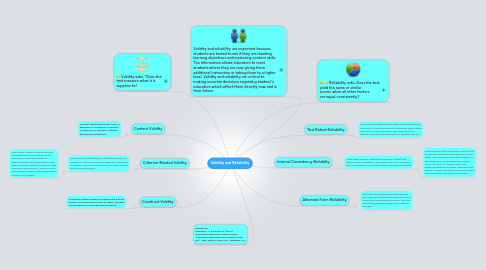Validity and Reliability
von shelia wilson


1. Content Validity
1.1. The test measures the skill, trait, or attribute it is suppose to measure. In other words, the test matches the learning objectives
2. Reference: Kubiszyn, T., & Borich, G. (2010). Educational testing & measurement: Classroom application and practice (9th ed.). John Wiley & Sons, Inc., Hoboken, NJ.
3. Construct Validity
3.1. Construct validity refers to determining if tests results corresond with scores on other variables as predicted by some rationale or theory.
4. Criterion-Related Validity
4.1. Scores are correlated with an external criterion or standard to obtain numerical evidence or estimate of validity. There are two types; Concurrent validity and predictive validity.
4.1.1. Concurrent validity is determined by correlating test scores given at the same time. Predictive validity is determined by correlating test scores with a criterion measure collected after some time has passed. It refers to how well the test predicts future behavior or success of students.
5. Validity asks, "Does the test measure what it is suppose to?
6. Validity and reliability are important because students are tested to see if they are meeting learning objectives and mastering content skills. The information allows educators to meet students where they are now giving them additional instruction or taking them to a higher level. Validity and reliability are critical to making accurate decisions regarding student's education which affect them directly now and in their future.
7. Reliability asks, Does the test yield the same or similar scores when all other factors are equal consistently?
8. Alternate Form Reliability
8.1. Estimates are obtained by administering two alternate/equivalent tests to the same group and correlating the scores. The time interval between the tests are as short as possible.
9. Internal Consistency Reliabilty
9.1. Used when the test measures a single or unitary trait. There are two categories; Split half/Odd-even and item total correlations such as the Kuder-Richardson methods.
9.1.1. Split-half/odd-even estimates divide a test in half and correlates the halves with each other. This underestimates the reliability of the whole test so the Spearman-brown formula is used to correct them. The Kuder-Richardson methods determine the extent to which the whole test represents a faily consistent measure of a concept
